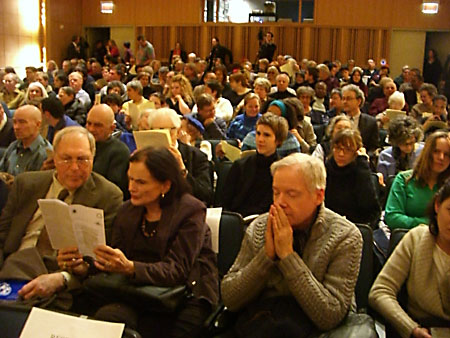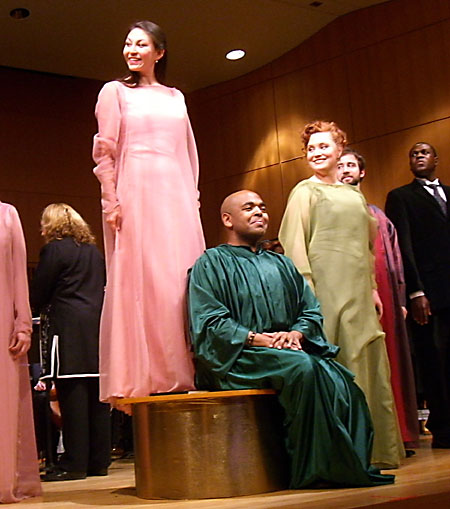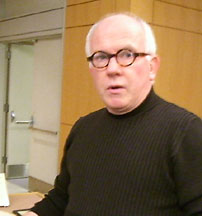|
Avoid the riots, reserve now. This is how Encompass New Opera Theatre advertised their March 15, 2009, Manhattan School of Music follow-on performance of Four Saints in Three Acts, the 1934 opera by Virgil Thomson based on an experimental libretto by Gertrude Stein. The Steiny Road Poet says "follow-on" because Encompass, under the direction of Nancy Rhodes, produced at the CUNY Graduate Center's Elebash Recital Hall February 20, 2009, for the occasion of the opera's 75th anniversary of its recording-setting 60-performance Broadway premier, Four Saints to an over-capacity audience, some of whom got locked out of the show.
 |
Much to the consternation of Dr. Frank Hentschker, Director of Programs at the Martin E. Segal Theatre Center of the CUNY Graduate Center who initiated and sponsored the celebration, among those barred from the auditorium were panelist composers and board members of the co-sponsoring Virgil Thomson Foundation Charles Fussell and Scott Wheeler, who had to sneak around to a side door to hear the performance as they awaited their time in the spotlight with Rhodes, her music Director Mara Waldman, and members of the cast to talk about this opera that continues to lead the way for new opera today.
THE POWER OF THE PRESS
Most likely what caused the crush at the Elebash doors was that on February 20, 2009, the New York Times published a short article written by Anthony Tommasini about the event along with a seven-inch wide by four-and-a-half-inch high black-and-white photo taken of the original production. What is seen in this photo is man on one knee playing a lute between the two attentive Saint Teresas. Three dancers seated on the stage floor lean in (dancers one and two) on either side of the Teresas while the third crooks her arm just behind the lute player. Cellophane palm trees stand behind the Teresas creating an abstract suggestion with their pointed leaves of white birds in flight. The rest of the photo is filled out with a dense population of choral singers dressed in choir robes. Mind you, this originating cast was entirely African Americans.
BLACK, WHITE OR NUDE?
Black singers had never before been cast to sing opera for white audiences. According to Steven Watson's research documented in his book Prepare for Saints: Gertrude Stein, Virgil Thomson, and the Mainstreaming of American Modernism (p.201), while the Colored American Opera Company existed as early as 1873 with others such as the National Negro Opera Company following suit, so-called high-culture productions featuring black characters were at that time cast with white performers, including Louis Gruenberg's 1933 operatic adaptation of Eugene O'Neill's The Emperor Jones where the black "emperor" was sung by white baritone Lawrence Tibbett. The Steiny Road Poet believes that while Virgil Thomson, relative to his cast selection, was influenced by such people as Carl Van Vechten, a bon vivant journalist-novelist-photographer who not only wrote about the black culture of Harlem (in 1924, Van Vechten published his controversially titled novel, Nigger Heaven) but also took his friends uptown to enjoy the exigencies found there, that Stein herself, in her 1909 story "Melanctha," about middle class black people, and by mentioning "Negroes" in the text of Four Saints, subliminally influenced Thomson's selection of an all-black cast.
This is not to say that either Van Vechten or Stein entirely supported Thomson's choice. Watson, who also participated in the CUNY celebration, documented Van Vechten expressing skepticism based on the fact that Four Saints did not concern black life. Watson reported that Thomson "tartly" replied, "Think how many opera stars have blacked up to sing Amonasro and Aida. Why can't my colored singers white up for Four Saints?" (p. 200) Watson noted that when Stein was informed that there was a possibility that the performers might be costumed in transparent cellophane, she said, "I suppose they have good reasons for using Negro singers instead of white, there are certain obvious ones, but I do not care for the idea of showing the Negro bodies, it is too much what the English in what they call 'modernistic' novels call futuristic and do not accord with the words and music to my mind." (p. 207) By the time of the premier, which occurred at the Wadsworth Antheneum in Hartford, Connecticut, the black cast was fully clothed in saintly opaque robes and without the white makeup notably seen in minstrel shows. Without a blink of doubt, even the risk takers who were into the Negro chic of the Harlem Renaissance were worried about bringing a black cast into a white venue before a white audience.
Flipping to 2008-2009 when America overwhelmingly elected and inaugurated Barack Obama, the Nation's first African-American president, Nancy Rhodes obsessed about not being able to enlist a black choir because the planning period for the CUNY event was less than a year's time and the choirs she wanted were fully booked. Nonetheless, her multiracial cast featuring Laura Choi Stuart, Anna Tonna, Roland Burks, Jennifer J. Winn, Nils Neubert, Ross Benoliel, Eve Gigliotti, and John Dominick III presented themselves as, what the Steiny Road Poet would describe, the perfect expression of our time—America is the melting pot now as never before. The energetic interpretations of Stein's quirky libretto sung by soprano Laura Choi Stuart as Saint Teresa I, mezzo Eve Gigliotti as the Commère, baritone Roland Burks as Saint Ignatius (he sings the "pigeons on the grass" interlude) and the sweetly modulated tenor of Nils Neubert put the SR Poet into a blissful state the likes of which she had never previously experienced.
 |
She thought after a year of walking around with her iPod, listening to the Orchestra of Our Time recording of Four Saints that a live production of this joyful marriage of music and text would send her flying with ecstasy. No, while the Poet enjoyed perfect harmony with the words and music of the Encompass production, she felt rooted to Earth in a way that was full of breath and restful awareness.
NAVIGATING SPACE—LIMITED AND OTHERWISE
Undoubtedly, the fact that Rhodes had been able, against all odds, to squeak through and find enough funding to hire the New Jersey Arts Collective's New Music Ensemble, Ionisation, a sixteen-piece orchestra that included such unusual instruments as an accordion and a harmonium, made a huge difference in how this concert version of Four Saints would sound. Initially Rhodes thought she would have to do the production with piano accompaniment only. Another challenge about the Elebash is that it is not set up for theatrical presentations. It is a recital hall and that means lighting and standard supporting theater elements are minimal to nonexistent. Also the Elebash stage is small, but Rhodes managed to have three dancers on stage—Kimberly Giannelli, Mia-Imani Jackson, and Justin Sherwood who were credibly able to navigate the limited space. On more than one occasion, the Poet has seen Rhodes work theatrical magic with the most minimal stages because of her rapport with the performers.
Here the Steiny Road Poet will shortly jump from New York to Chicago to provide a contrast in theatrical resources. This little interlude comes with thanks to Hans Gallas, who provided an exhibition of Stein memorabilia for the CUNY Graduate School Four Saints celebration.  On the morning of February 20, the Poet went to the Graduate Center to make sure things were tracking for the daylong event. She visited with Gallas who pointed out an original program from the Chicago production. The Poet who had just been in Chicago February 11th through 14th for the Associated Writing Programs (AWP) convention and book fair, then said she had been wondering at what theater in Chicago Four Saints had played. Gallas pointed out Auditorium Theatre located on Michigan Avenue printed on the front of that program brochure and suddenly the light went on in the Steiny Road Poet's head. On the morning of February 20, the Poet went to the Graduate Center to make sure things were tracking for the daylong event. She visited with Gallas who pointed out an original program from the Chicago production. The Poet who had just been in Chicago February 11th through 14th for the Associated Writing Programs (AWP) convention and book fair, then said she had been wondering at what theater in Chicago Four Saints had played. Gallas pointed out Auditorium Theatre located on Michigan Avenue printed on the front of that program brochure and suddenly the light went on in the Steiny Road Poet's head.
At the AWP convention everyone had been abuzz about the architecturally sensational theater where the AWP keynote speaker was presented on February 11. The Poet had missed this event in favor of attending a reading in another Chicago venue by Sarah Browning, a poet the SR Poet as president of The Word Works had helped get published. The next day, the Poet had lunch with Juanita Rockwell, the librettist of The World Is Round, an opera by composer James Sellars and based on Gertrude Stein's children story by the same title. (And Rockwell's opera with Sellars premiered where? The Wadsworth Antheneum!) Rockwell also touted the Chicago theater, which has an unblocked line of sight for nearly 4,000 people. After the Poet and her friend left the restaurant, they walked by Auditorium Theatre and the Poet said, "How about coming with me to see the theater?" So, with some kind of divine luck, the stage manager was in and willing to let the pair enter the grand but quiet auditorium to feast their eyes on the red and gold décor of this enormous but some how intimate space. And neither knew this was where Four Saints in Three Acts had played with Gertrude Stein and her partner Alice B. Toklas attending the opening night on November 7, 1934. Imagine what Encompass and Nancy Rhodes could have done with this space.
However, it is the job of small opera companies to cause riots whenever possible. In the face of diminishing resources, and that includes not only money but also audience who flock in the thousands to hear popular music over opera, to cause an over-capacity crowd who are pressing against the doors to get in is balm for all the other battle wounds along the Steiny Road to Operadom.
|

